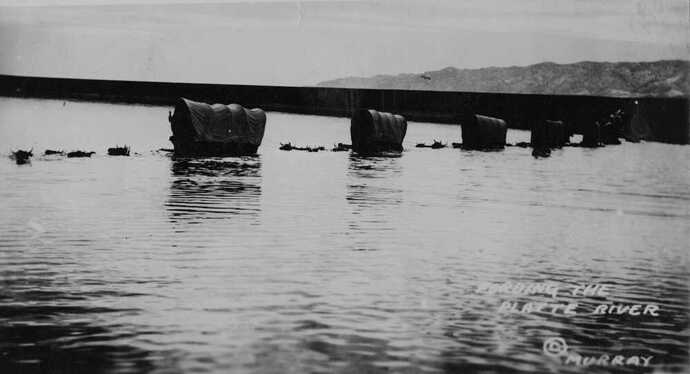Folks , I am wondering why this event took place in 1847...? That timeline was significant - not too long after the disappearance of William Morgan and the Hollow earth evangelism of Symmes...the Hollow Earth was quite a prominent idea even in 1847...a famous Hollow Earth believer such as Edgar Allan Poe (with Mormon friends) was still alive at that time - any thoughts , comments about the possible correlations of this event to the idea of Hollow Earth ?
The Great Mormon Migration
Wagon train crossing the Platte River 1840s-1850s. Courtesy: Special Collections Dept., J. Willard Marriott Library, University of Utah.
They were a people who felt called by God, chosen to create a New Jerusalem. It was fitting, then, that in order to realize the dream, the Mormons endured a 1,300-mile journey of Biblical proportions.
Time to Go
Mormons had been considering moving west -- beyond the borders of the United States -- since before Joseph Smith's 1844 murder, but his assassination made it clear that the period of relative calm the Mormon faithful had enjoyed in Nauvoo, Illinois, was coming to an end. In 1845 mob violence against the Mormon community increased, and the Illinois legislature revoked the city's charter.
Exodus, Part One
Brigham Young, who was emerging as the church's new leader, conducted a census that fall, counting more than 3,000 families and some 2,500 wagons. He then divided church members into smaller administrative groups of tens, fifties, and hundreds (following the pattern described in the Old Testament when, after crossing the Red Sea dry-shod, the Jews went through the wilderness searching for the Promised Land). Appropriately, Young named the collective the Camp of Israel. Although Young hoped to begin the migration in spring 1846, local hostility forced the Mormons' hand. The first wave of about 3,000 people began to leave Nauvoo in early February, and their suffering was intense. They crossed the frozen Mississippi River -- dry-shod. In one evening on the trek nine babies were born, their parents barely able to provide any shelter from the elements. Wagons collapsed, people died from exposure, and it took 131 days for the Mormon convoy to travel 310 miles to relative safety on the banks of the Missouri, where the river divided Nebraska and Iowa. Still, church members kept the faith throughout their tribulations. William Clayton, who had been ordered to travel ahead of his pregnant wife, was so overjoyed to learn of his son's birth that he wrote a hymn, "Come, Come, Ye Saints," that has become a Mormon standard. Its hopeful last line: "All is well! All is well!"
Winter Quarters
All was well for a time in the area (near what is Omaha, Nebraska today) that the Mormons reached in June 1846. Local Native Americans were friendly, and Young decided they would remain in what became known as "Winter Quarters" until the following spring. But when winter came, scurvy claimed as many as 15 percent of the camp members; Young's son would later call their settlement "the Valley Forge of Mormondom." Young, himself sick in February 1847, had been plagued by self-doubt, but a vision of Joseph Smith helped him become the strong leader his followers needed for the second, thousand-mile portion of their journey.
Exodus, Part Two
In April 1847, an advance party of 25 wagons led by Young left the Winter Quarters and headed towards the Rocky Mountains. They traveled along the Platte River, creating a new route on its north bank rather than risk encounters with other settlers on the Oregon Trail. The first half of the journey was along the plains and easier going than the mountains that loomed up past Fort Laramie, Wyoming. But the Mormons kept going, marching by day and leavening the evenings with campfire dance and song. There was also much sickness. Like many others in the pioneer band, Brigham Young came down with "mountain fever." On July 24, after 111 days of travel, a wagon carrying the prostrate Young reached the valley of the Great Salt Lake. Looking out on the terrain, Young declared, "It is enough. This is the right place."
A Permanent Home
As Young was reaching his destination, another wagon train with more than 1,500 people and nearly 600 cows was leaving Winter Quarters and heading west. Over the next two decades more than 60,000 Mormons would journey to the Utah Territory; thousands came by wagon, and thousands more pulled handcarts across the harsh terrain. Many died along the way, and the survivors found the country they sought to escape would soon expand its borders to encompass them. In 1857 during the "Utah War," the Mormons abandoned their Salt Lake City homes as the U.S. Army approached, but returned to them unscathed and would never again be forced to flee for their lives and abandon everything they knew; for the first time, they had found a permanent home.
Regards

